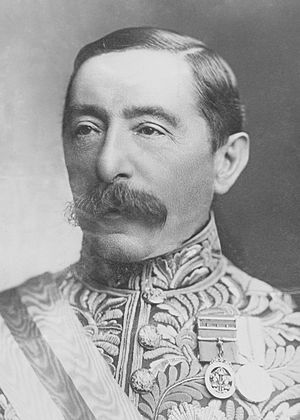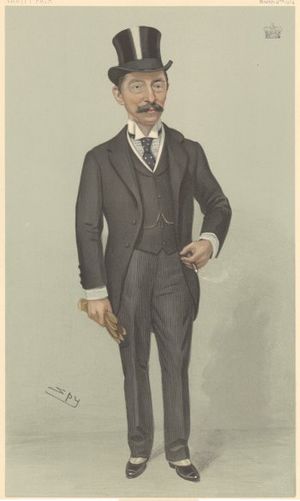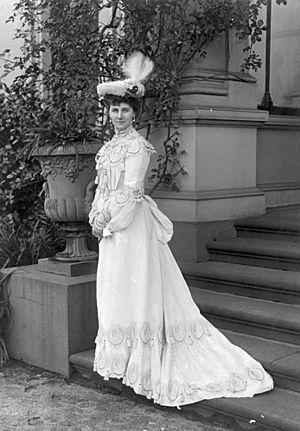Henry Northcote, 1st Baron Northcote facts for kids
Quick facts for kids
The Lord Northcote
|
|
|---|---|

Northcote in 1905
|
|
| 3rd Governor-General of Australia | |
| In office 21 January 1904 – 9 September 1908 |
|
| Monarch | Edward VII |
| Prime Minister | Alfred Deakin Chris Watson George Reid |
| Preceded by | Lord Tennyson |
| Succeeded by | Lord Dudley |
| Governor of Bombay | |
| In office 17 February 1900 – 5 September 1903 |
|
| Monarch | Victoria Edward VII |
| Governor General | Lord Curzon of Kedleston |
| Preceded by | William Mansfield |
| Succeeded by | James Monteath |
| Member of Parliament for Exeter |
|
| In office 1 April 1880 – 19 December 1899 Serving with Edward Johnson (1880–1885)
|
|
| Preceded by | John George Johnson |
| Succeeded by | Edgar Vincent |
| Personal details | |
| Born | 18 November 1846 London, England |
| Died | 29 September 1911 (aged 64) Ashford, Kent, England |
| Spouse |
Alice Stephen
(m. 1873) |
| Education | Eton College |
| Alma mater | Merton College, Oxford |
Henry Stafford Northcote, 1st Baron Northcote (born November 18, 1846 – died September 29, 1911) was an important British politician. He was a member of the Conservative Party. He is best known for being the third Governor-General of Australia, serving from 1904 to 1908. Before that, he was the governor of Bombay (a city in India) from 1900 to 1903. He also worked as a government minister under Prime Minister Lord Salisbury.
Northcote was the son of Stafford Northcote, 1st Earl of Iddesleigh. He studied at Eton College and Merton College, Oxford. Later, he worked for the Foreign Office, which handles international relations. He also served as a private secretary to his father. In 1880, Northcote was elected to the House of Commons, which is part of the British Parliament. He held various government roles, including Financial Secretary to the War Office and Surveyor-General of the Ordnance.
In 1900, he became the Governor of Bombay and was given the title of a "peer" (a noble title). He had already been made a "baronet" (another noble title) in 1887. When he became Governor-General of Australia in 1904, he brought much-needed stability. The two Governors-General before him had both left office early. Northcote was quite involved in Australian politics because the government system at the time was a bit unstable. He served for almost five years, but he resigned in 1908 after a disagreement with Prime Minister Alfred Deakin.
Contents
Early Life and Education
Henry Stafford Northcote was born in London, England. He was the second son of Sir Stafford Northcote, a well-known Conservative politician. His mother was Cecilia Frances.
He went to two famous schools: Eton College and Merton College, Oxford. After finishing his studies, he joined the Foreign Office, working as a diplomat.
Political Career and Public Service
Starting in Politics
From 1871 to 1873, Northcote worked as a secretary for the British team that was discussing the "Alabama Claims." These were disagreements between Britain and the United States.
From 1877 to 1880, he was the private secretary to his father, who was then the Chancellor of the Exchequer (in charge of the country's money). In 1880, Northcote was elected as a Member of Parliament (MP) for the area of Exeter. He held this position in the House of Commons for 19 years, until 1899.
He worked under Prime Minister Lord Salisbury. Northcote was the Financial Secretary to the War Office from 1885 to 1886. He was also the Surveyor-General of the Ordnance from 1886 to 1888. In 1887, he was given the title of Baronet. When he left Parliament in 1900, he was honored with the "Freedom of the City" of Exeter.
Governor of Bombay
In November 1899, Northcote was chosen to be the Governor of Bombay. This was a very important role in British India. He was given the noble title of Baron Northcote in January 1900.
Lord and Lady Northcote traveled from London and arrived in Bombay in February 1900. He officially started his role as Governor on February 17, 1900. On the same day, he received another special honor, becoming a Knight Grand Commander of the Order of the Indian Empire.
Governor-General of Australia
In 1903, while he was still Governor of Bombay, Northcote was offered the job of Governor-General of Australia. This was a very important position, representing the British King in Australia. The first two Governors-General had left their jobs early and had some difficulties with Australian leaders. Both the British and Australian governments wanted someone who could bring stability. Northcote was chosen for a five-year term.
His many years in politics and his experience as Governor of Bombay made him a good choice. He was seen as friendly and easy to get along with, which helped him connect with both politicians and the public in Australia.
Northcote was the first Australian Governor-General to face political challenges. Australia's government had three main parties, which made things unstable. In April 1904, Prime Minister Alfred Deakin resigned. Then, Chris Watson (Labor Party) and George Reid (Free Trade Party) became Prime Minister, but only for short periods, before Deakin became Prime Minister again. Both Watson and Reid asked Northcote to call a new election before they resigned, but he said no both times. At that time, everyone agreed that the Governor-General had the power to make these decisions. It shows how respected Northcote was that all these leaders accepted his choices.
Northcote also saw himself as a diplomat for the British government. He helped with discussions between Britain and Australia on trade and shipping. However, his influence in London decreased after 1906 when the Liberal Party took power in Britain.
In 1907, Northcote and Prime Minister Deakin had a disagreement. The British government told Northcote not to approve a new Australian law. This law would have stopped appeals from Australian courts to the Privy Council in London. Deakin believed that Australian laws should be decided in Australia. He told Northcote this directly. Because of this, Northcote announced in February 1908 that he wanted to resign a year early. He left Australia in September. He received more honors, becoming a Knight Grand Cross of the Order of St Michael and St George in 1904 and a member of the Privy Council of the United Kingdom in 1909.
Family Life
Lord Northcote married Alice Stephen in 1873. Alice was the adopted daughter of George Stephen, 1st Baron Mount Stephen. They did not have any children. Lady Northcote also received special honors. She became a Companion of the Order of the Crown of India in 1900 and a Dame Commander of the Order of the British Empire in 1919.
Northcote was also involved in the Masonic organization, serving as a leader for Devon in the United Grand Lodge of England.
After returning to Britain from Australia, Northcote's health got worse. He passed away on September 29, 1911, at the age of 64. Since he had no children, his noble title of "Baron" ended when he died. Lady Northcote passed away in June 1934.
Sources
- Serle, Percival (1949). "[{{{Link}}} Northcote, Henry Stafford]". Dictionary of Australian Biography. Sydney: Angus and Robertson.
- Donald Markwell. "Griffith, Barton and the early governor-generals: aspects of Australia's constitutional development", Public Law Review, 1999.
| Parliament of the United Kingdom (1801–present) | ||
|---|---|---|
| Preceded by Arthur Mills John George Johnson |
Member of Parliament for Exeter 1880–1899 |
Succeeded by Edgar Vincent |
| Party political offices | ||
| Preceded by Charles Stuart-Wortley |
Chairman of the National Union of Conservative Constitutional Associations 1893 |
Succeeded by James Rankin |
| Political offices | ||
| Preceded by Sir Arthur Hayter, Bt |
Financial Secretary to the War Office 1885–1886 |
Succeeded by Herbert Gladstone |
| Military offices
|
||
| Preceded by William Woodall |
Surveyor-General of the Ordnance 1886–1887 |
Succeeded by Post abolished |
| Government offices
|
||
| Preceded by The Viscount Sandhurst |
Governor of Bombay 1900–1903 |
Succeeded by The Lord Lamington |
| Preceded by The Lord Tennyson |
Governor-General of Australia 1904–1908 |
Succeeded by The Earl of Dudley |
| Peerage of the United Kingdom | ||
| New creation | Baron Northcote 1899–1911 |
Extinct |
| Baronetage of the United Kingdom | ||
| New creation | Baronet (of Seamore Place) 1887–1911 |
Extinct |



